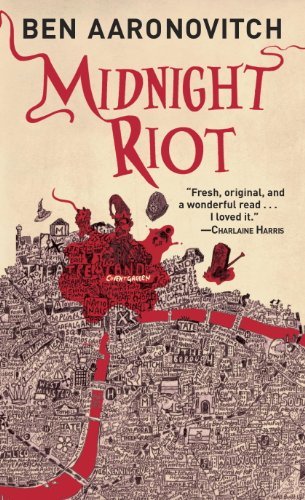Ben Aaronovitch and the Rivers of London
 Suppose you’re a new constable in the London police force, one Peter Grant, and suppose you’re at the scene of a horrific murder, and suppose you run into the only witness, and suppose that witness is a ghost. Reporting that leads to you becoming attached to the heretofore secret branch of the Met for supernatural crime, manned by one very old inspector named Nightingale (born 1900), who doesn’t look a day over sixty and appears to be getting younger, and moving into the old mansion that houses that supernatural branch where you’re taken care of by a hollow-eyed, black-haired housekeeper named Molly who has too many teeth and a taste for red meat and where you learn that all the waterways of London have their own goddesses, including the dangerous Lady Tyburn and the impudent Beverley Brook.
Suppose you’re a new constable in the London police force, one Peter Grant, and suppose you’re at the scene of a horrific murder, and suppose you run into the only witness, and suppose that witness is a ghost. Reporting that leads to you becoming attached to the heretofore secret branch of the Met for supernatural crime, manned by one very old inspector named Nightingale (born 1900), who doesn’t look a day over sixty and appears to be getting younger, and moving into the old mansion that houses that supernatural branch where you’re taken care of by a hollow-eyed, black-haired housekeeper named Molly who has too many teeth and a taste for red meat and where you learn that all the waterways of London have their own goddesses, including the dangerous Lady Tyburn and the impudent Beverley Brook.
That’s the start of Ben Aaronovitch’s Rivers of London series that includes six novels (so far), a novella, and a series of graphic novels. It’s not Harry Potter for adults, it’s much more than that as it draws on history and mythology and sociology and computer science, so maybe it’s for Harry Potter fans who thought the books would have been better with more sex, violence, diversity (Peter’s mixed race), and in-depth discussion about the practical theory of magic. There’s some X-Files in there, too, and a dash of Supernatural, but mostly the Rivers novels are their own things, endlessly inventive and compelling. The stories are always complex, which means that I need to reread each one to completely understand what’s going on, but that’s okay because they give me a marvelous world full of fascinating characters I always want to read again.
However, if you want your Big Bad defeated, you’re going to get frustrated because there are several of them, and they’re still roaming around free at the end of the sixth novel. I think there’s a limit to how long this battle can be stretched out—Peter does solve each mystery in each book, he just can’t catch the bad guy—so I’m hoping it gets resolved in the next novel, whenever that comes out. The novella is excellent if unsatisfying—it reads like an unfinished novel with an abrupt finish—and the graphic novels are not good. But the novels are damn good reads.
Therefore, I highly recommend the Rivers of London. And right now, Midnight Riot is $.99 on Amazon, probably because they know if you read one, you’ll go head first into all of them.

Midnight Riot in US/Rivers of London in UK, 2011:
Peter meets a ghost and Nightingale and Molly and rescues a dog, Toby, and tangles with the beautiful Beverly and the dangerous Lady Ty, while working with Lesley, a fellow officer, to solve supernatural murders. One of the most intricate and convoluted plots I’ve ever read—I really didn’t understand half of it until I read it again, didn’t get some of the rest of it until the third time, and I’ll probably grasp more the fourth time—it’s still a great story with a wonderful protagonist and an antagonist like no other. The world-building is marvelous, not just establishing modern London but also the intricate social structure of the supernatural world, especially the Thames family, aka the warring Rivers of London, and the different magic spells and rules that the very special branch is armed with. (It’s helpful if you’re familiar with Punch and Judy shows, too.) The ending is brutal, but the sense of justice is strong.
 Moon over Soho, 2011:
Moon over Soho, 2011:
Peter gets entangled with a jazz-loving woman named Simone and spends a good chunk of the book naked with her, which made me think less of him because there was nothing about her that was intelligent or interesting (until the end), and nothing about their relationship that was anything but sex, but that may be because I’m a hetero woman; a cheerful, pastry-loving sex addict is probably many readers’ idea of a good time. But he’s also trying to help Lesley in the aftermath of the last book, and he’s still dealing with the Rivers of London, those gods and goddesses of the waterways, and the crimes are once again complex and never boring. Plus this time, his mom and dad are involved, which means jazz. Even Simone is crucial in the end, so I’ll stop complaining about her. Also good: the introduction of a series heavy who’s a real bastard: the Faceless Man.

Whispers Underground, 2012:
A young man is killed in the Underground, and Peter and the rest have to go down even farther, this time into the sewers, to discover who killed him, while still chasing the Faceless Man from the last book. A minor subplot is the most fun: Abigail, a thirteen-year-old girl with attitude who lives in the same housing block at Peter’s mother, tells him there’s a ghost on the train tracks. Abigail isn’t impressed by anyone, but at the end, she agrees to help out with unseeable that she can see, setting up a great new addition to the Folly Team.
 Broken Homes, 2014:
Broken Homes, 2014:
Something odd is happening in a housing project with a very strange design, and Peter and Lesley and Nightingale and the hijab-wearing Officer Sahra Guleeb are on the case, which involves strange deaths, stolen magic books, a tree nymph, and a lot of explosions, the biggest one at the climax. The usual great cast of supporting characters and evil antagonists are present and accounted for, and Peter faces down the Faceless Man at the end. Needs more Abigail, but otherwise great.
 Foxglove Summer, 2015:
Foxglove Summer, 2015:
Two elementary schoolgirls go missing in the country and Peter is sent down to help find out why. I think one of the reasons I like this book the least is because it’s untethered from the core group; Peter makes new friends and Beverley Brook shows up, always a good thing, but the Folly family is shattered, and the solution to the mystery this time is so far out that even though the characterizations are once again excellent, the plot seems weak, especially given an ending that comes out of left field, making no sense given the logic of world, and ends so abruptly that I was surprised when I turned the page to see there was no more left I’ll stick with the series, it’s too good not to, but this wasn’t great. Also the Big Bads who are still wandering around from the last three books? Must be taking a vacation since all they do is text.
Body Work, 2015, and Night Witch, 2016 (Graphic Novels) 
I had once thought about doing a novel (or two) and then doing the sequels as graphic novels. These two graphic novels convinced me not to do this for a many reasons, but the big one is that you don’t switch genres in the middle of a series without seriously screwing with reader attachment. This is not the way I see these people looking or moving, so it feels to me like an imposter story. Add to that, the stories are weak, the art is not good, and neither of these uses the graphic novel format as its own language; instead they’re just illustrated short stories. I won’t be buying any more (there are other collections), and they don’t seem to be necessary to understand the novels.
 The Hanging Tree, January 2017
The Hanging Tree, January 2017
Lady Ty calls in a promise and Peter and Nightingale get involved with a simple drug overdose that quickly becomes The Big Bad is Back, which means it’s not that damn simple. No Abigail, which is just wrong, but enough Beverley and Guleed and even more new characters I’d like to see again to bring me back for the next one. By this point, the Rivers books have built a complete and coherent world, populated by wonderful characters, even if the plots require re-reading to figure it all out.

“The Furthest Station” (novella) June 2017
Ghosts, kidnapping, a baby river god, and Abigail in a major role at last. The only drawback is that it’s much too short and ends much too abruptly.
Seriously, if you like mysteries with some scientific supernatural thrown in, read The Rivers of London books.

SaveSave
SaveSave
The post Ben Aaronovitch and the Rivers of London appeared first on Argh Ink.




